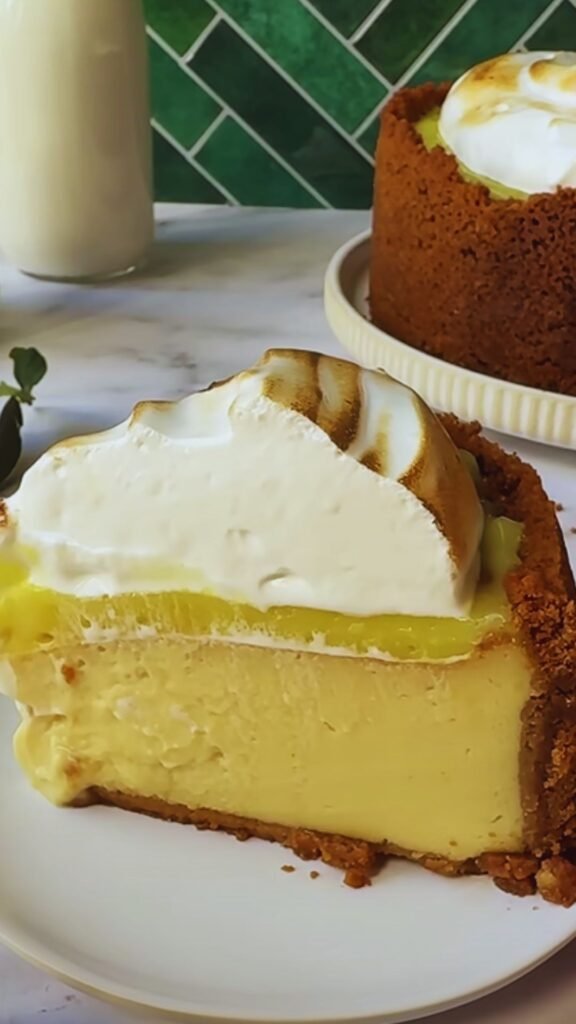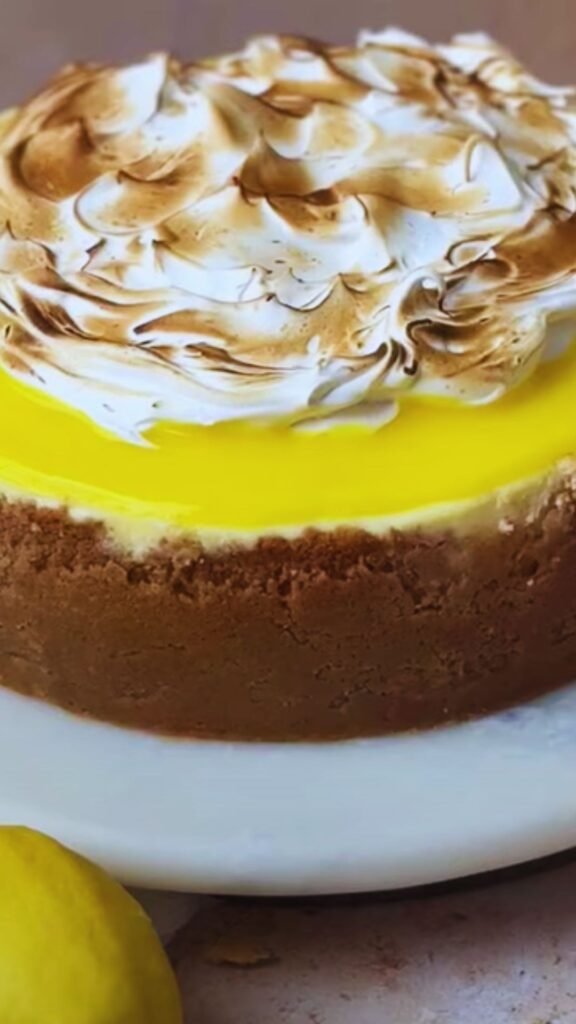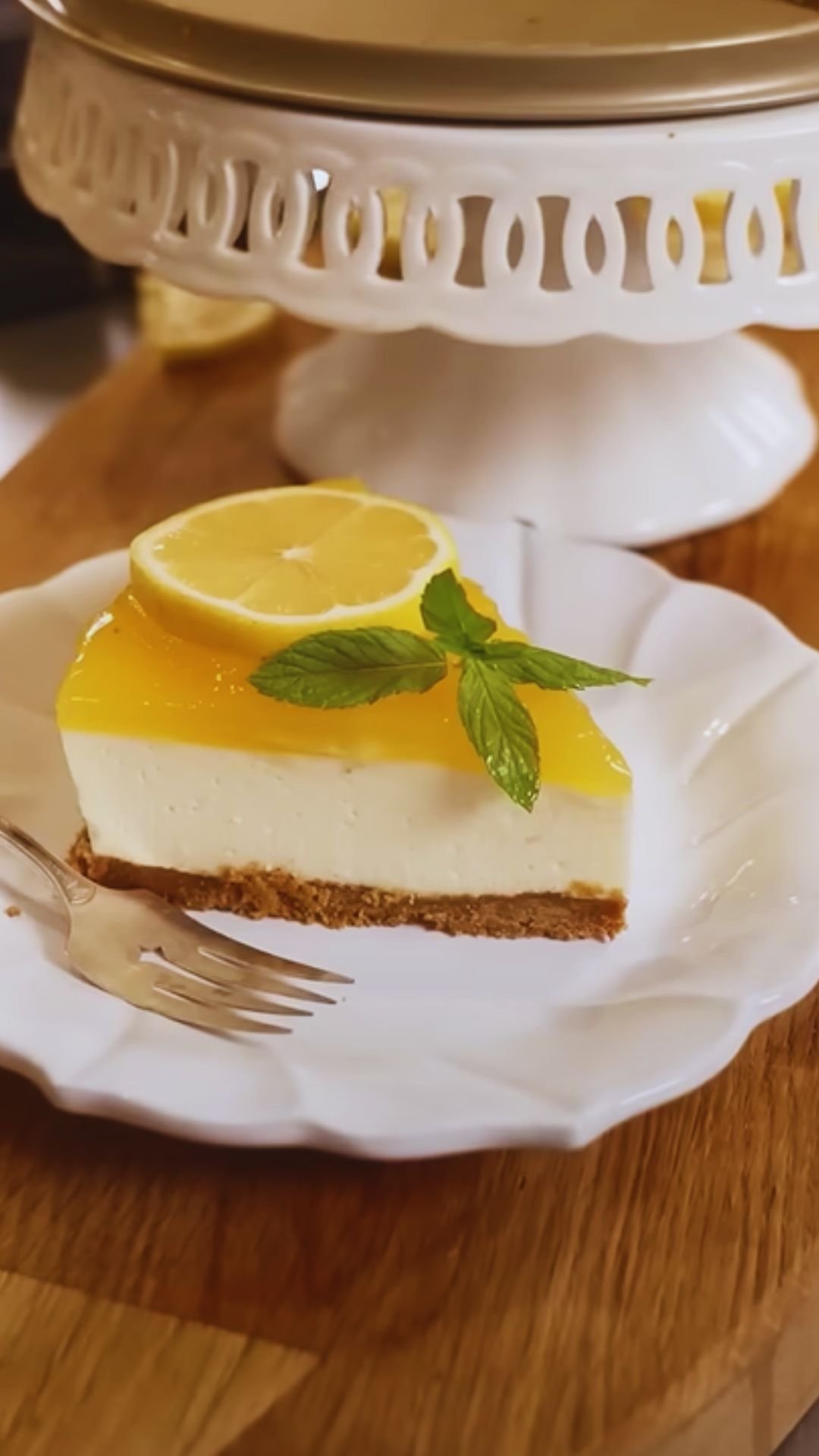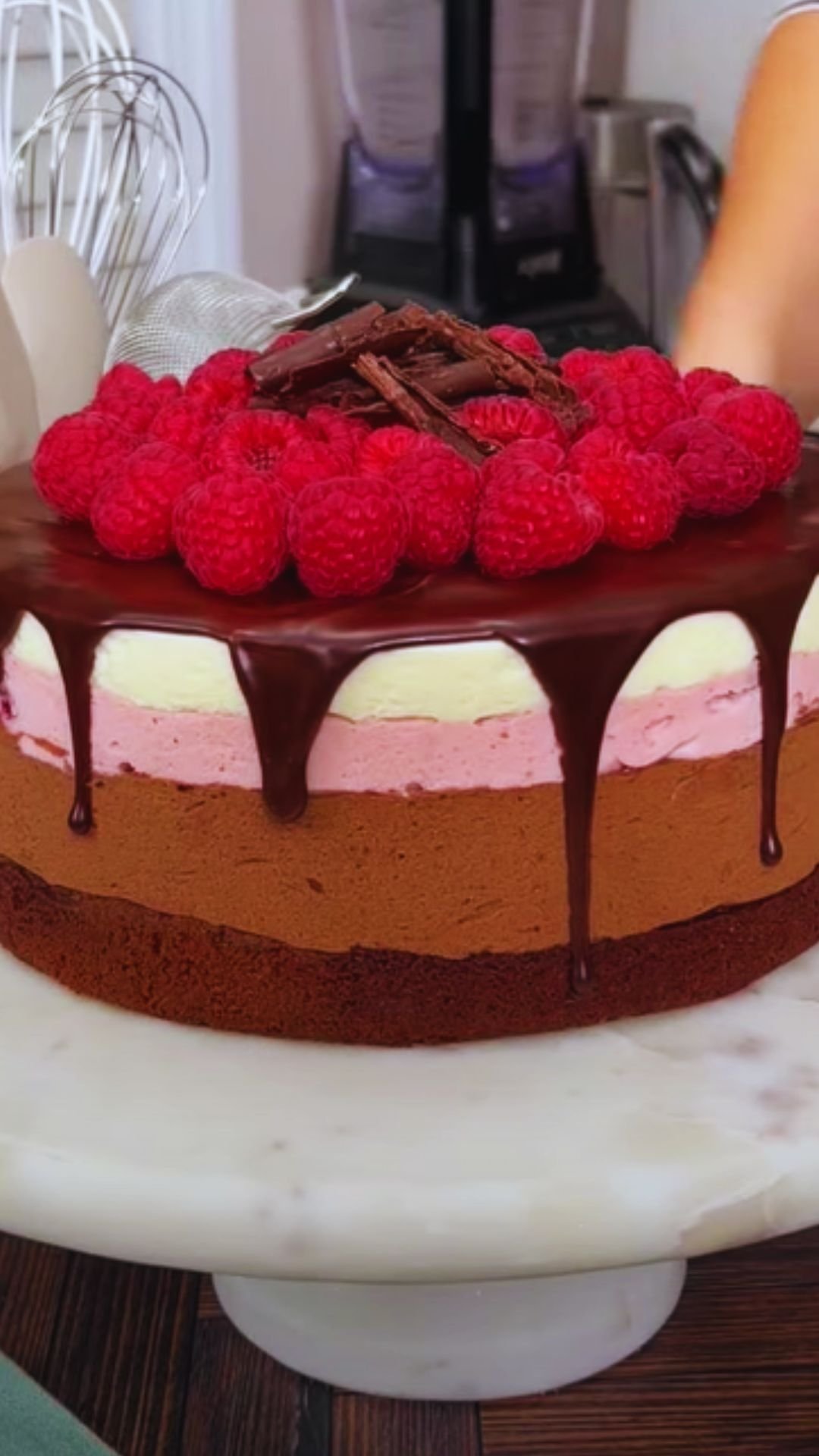Have you ever found yourself torn between ordering a tangy lemon meringue pie or a rich, creamy cheesecake for dessert? I certainly have, and after years of this internal debate, I finally decided: why choose when you can have both? That’s how my Triple Lemon Meringue Cheesecake was born—a glorious three-layer dessert that combines the best of both worlds and then some.
I’ve spent countless hours perfecting this recipe in my kitchen, testing various techniques to ensure every layer delivers maximum lemon flavor. The result is a stunning dessert that features a buttery lemon cookie crust, a velvety lemon cheesecake middle, and a fluffy toasted meringue topping—all enhanced with fresh lemon curd that ties everything together.
Whether you’re planning a special celebration or simply want to treat yourself to something extraordinary, this showstopper dessert is guaranteed to impress. Let me walk you through exactly how to create this citrus masterpiece in your own kitchen.
What Makes This Triple Lemon Meringue Cheesecake Special?
Before we dive into the recipe, let me explain why this dessert deserves a spot in your repertoire:
- Triple lemon impact: Lemon appears in the crust, the cheesecake filling, and the lemon curd layer for an unmistakable citrus experience
- Perfect texture contrast: Crisp cookie base, creamy cheesecake middle, and light, airy meringue topping
- Make-ahead friendly: Components can be prepared in advance for less stress when entertaining
- Stunning presentation: The golden peaks of torched meringue create a dessert that looks as amazing as it tastes
- Balanced flavor profile: The sweetness of the meringue perfectly counteracts the tanginess of the lemon
Ingredients
For the Lemon Cookie Crust:
- 300g lemon sandwich cookies (approximately 25-30 cookies)
- 85g unsalted butter, melted
- 1 tablespoon lemon zest
- Pinch of salt
For the Lemon Cheesecake Filling:
- 900g cream cheese, at room temperature
- 250g granulated sugar
- 3 large eggs, at room temperature
- 2 large egg yolks, at room temperature
- 60ml fresh lemon juice
- 2 tablespoons lemon zest
- 1 tablespoon vanilla extract
- 240ml sour cream, at room temperature
- 2 tablespoons all-purpose flour
For the Lemon Curd:
- 6 large egg yolks
- 200g granulated sugar
- 120ml fresh lemon juice
- 2 tablespoons lemon zest
- 113g unsalted butter, cut into cubes
- Pinch of salt
For the Meringue Topping:
- 6 large egg whites, at room temperature
- 300g granulated sugar
- 1/4 teaspoon cream of tartar
- 1 teaspoon vanilla extract
- Pinch of salt
Special Equipment
Before getting started, make sure you have these tools ready:
- 9-inch springform pan
- Parchment paper
- Food processor
- Electric mixer (stand or handheld)
- Rubber spatula
- Zester or microplane
- Kitchen torch (for toasting the meringue)
- Candy thermometer (for the meringue)
- Large heat-proof bowl
- Heavy-bottomed saucepan

Detailed Instructions
Preparing the Lemon Cookie Crust
- Preheat your oven to 160°C (325°F).
- Wrap the outside of a 9-inch springform pan with heavy-duty aluminum foil, making sure it comes at least halfway up the sides. This prevents water from seeping in during baking.
- In a food processor, pulse the lemon cookies until they form fine crumbs.
- Add the melted butter, lemon zest, and pinch of salt to the crumbs and pulse until the mixture resembles wet sand.
- Press the mixture firmly and evenly into the bottom of the prepared springform pan, using the flat bottom of a measuring cup to compact it.
- Bake the crust for 10 minutes until slightly golden. Remove from the oven and let cool completely.
- Reduce the oven temperature to 150°C (300°F).
Making the Lemon Cheesecake Filling
- In a large mixing bowl, beat the cream cheese on medium speed until completely smooth, about 3-4 minutes. Scrape down the sides of the bowl frequently to ensure there are no lumps.
- Gradually add the sugar and beat until smooth and incorporated, about 2 minutes.
- Add the eggs and egg yolks one at a time, beating on low speed after each addition just until combined. Do not overmix!
- Add the lemon juice, lemon zest, and vanilla extract, mixing on low speed until just incorporated.
- Fold in the sour cream until fully combined.
- Sift the flour over the mixture and fold gently until incorporated.
- Pour the filling over the cooled crust and smooth the top with a spatula.
Water Bath Baking Method
- Place the foil-wrapped springform pan in a larger roasting pan.
- Pour hot water into the roasting pan until it reaches about halfway up the sides of the springform pan.
- Carefully transfer to the preheated oven and bake for 65-75 minutes, or until the edges are set but the center still has a slight jiggle.
- Turn off the oven, crack the door open slightly, and let the cheesecake cool in the oven for 1 hour.
- Remove from the oven and water bath, discard the foil, and let cool completely on a wire rack.
- Cover and refrigerate for at least 6 hours or overnight.
Preparing the Lemon Curd
- In a heat-proof bowl, whisk together the egg yolks and sugar until well combined.
- Add the lemon juice, zest, and salt, and whisk until smooth.
- Set the bowl over a saucepan of simmering water (make sure the bottom of the bowl doesn’t touch the water).
- Cook, whisking constantly, until the mixture thickens enough to coat the back of a spoon, about 10-12 minutes. The temperature should reach 170°F (77°C) on an instant-read thermometer.
- Remove from heat and whisk in the butter, a few cubes at a time, until fully incorporated and the curd is smooth.
- Strain the curd through a fine-mesh sieve to remove any bits of zest or cooked egg.
- Press plastic wrap directly on the surface of the curd to prevent a skin from forming.
- Refrigerate until completely chilled, at least 2 hours.
Creating the Perfect Meringue Topping
- In a large, clean, heat-proof bowl, combine the egg whites, sugar, cream of tartar, and salt.
- Set the bowl over a saucepan of simmering water (not touching the bottom).
- Whisk constantly until the sugar dissolves and the mixture reaches 160°F (71°C) on a candy thermometer. This step ensures food safety and creates a stable meringue.
- Remove from heat and transfer to the bowl of a stand mixer fitted with the whisk attachment (or use a hand mixer).
- Add the vanilla extract and beat on medium-high speed until stiff, glossy peaks form and the mixture has cooled, about 5-7 minutes.
Assembling the Triple Lemon Meringue Cheesecake
- Remove the chilled cheesecake from the refrigerator and carefully release it from the springform pan.
- Spread the lemon curd evenly over the top of the cheesecake, leaving a small border around the edge.
- Transfer the meringue to a piping bag fitted with a large star tip, or simply spoon it over the lemon curd layer.
- Use a kitchen torch to carefully toast the meringue until golden brown. Alternatively, you can place it under a broiler for a very brief time, watching carefully to avoid burning.
- Refrigerate for at least 30 minutes before serving to allow the layers to set.

Troubleshooting Guide
| Issue | Possible Cause | Solution |
|---|---|---|
| Cheesecake has cracks | Overmixing the batter or baking at too high a temperature | Mix just until ingredients are combined; ensure oven temperature is accurate |
| Crust is soggy | Water bath leaked or crust wasn’t pre-baked | Ensure foil is secured properly; pre-bake crust until lightly golden |
| Meringue weeps or deflates | Sugar not fully dissolved or overbeaten | Heat egg white mixture until sugar completely dissolves; don’t overbeat meringue |
| Lemon curd is too runny | Not cooked long enough | Cook until mixture thickens and coats the back of a spoon (170°F) |
| Cheesecake isn’t set in the center | Underbaking | Bake until edges are set but center still has a slight jiggle |
| Meringue browns too quickly | Torch held too close | Keep torch moving and hold it several inches away from the meringue |
Expert Tips for the Perfect Triple Lemon Meringue Cheesecake
After making this recipe countless times, I’ve gathered some invaluable tips that will help you achieve spectacular results:
- Room temperature ingredients: This is non-negotiable for the cheesecake filling. Cold cream cheese will never fully incorporate and will leave you with a lumpy batter.
- The lemon trifecta: For maximum flavor, use both zest and juice, and don’t skip the lemon cookies in the crust—they add another dimension of citrus flavor.
- Patience is key: Allow ample time for each component to cool and set properly. Rushing the process will compromise both texture and flavor.
- Strain your lemon curd: This extra step ensures a silky-smooth texture without any bits of cooked egg.
- Water bath essentials: Don’t skip this step! It creates a gentle, moist heat that prevents cracking and ensures even baking.
- Gradual cooling: Allowing the cheesecake to cool slowly in the turned-off oven prevents dramatic temperature changes that can cause cracks.
- Double-wrap that foil: Use heavy-duty foil and wrap it at least twice around your springform pan to prevent any water from seeping in.
Make-Ahead and Storage Information
| Component | Make-Ahead Timeline | Storage Method | Maximum Storage Time |
|---|---|---|---|
| Lemon Cookie Crust | Up to 3 days ahead | Wrapped in springform pan at room temperature | 3 days |
| Cheesecake (baked) | Up to 5 days ahead | Refrigerated, covered tightly | 5 days |
| Lemon Curd | Up to 1 week ahead | Refrigerated in airtight container | 1 week |
| Fully Assembled Cheesecake | Up to 2 days ahead | Refrigerated, loosely covered | 2 days |
| Leftovers | – | Refrigerated, covered | 3-4 days |
| Frozen Cheesecake (without meringue) | Up to 1 month | Wrapped well and frozen | 1 month |
When freezing, I recommend freezing just the cheesecake with the lemon curd layer, then adding fresh meringue after thawing. The meringue doesn’t freeze well and can become watery when thawed.
Serving Suggestions
For the ultimate presentation of your Triple Lemon Meringue Cheesecake, consider these serving ideas:
- Garnish with thin lemon slices, candied lemon peel, or edible flowers
- Serve with a small dollop of lightly sweetened whipped cream on the side
- Add a sprinkle of crushed lemon cookies around the base for additional texture
- Pair with a cup of Earl Grey tea or a bright citrus tea
- For a refreshing summer treat, serve with a small scoop of lemon sorbet
- Drizzle each plate with a small amount of raspberry coulis for a beautiful color contrast
- Garnish the serving plate with fresh mint leaves and a light dusting of powdered sugar

Variations to Try
While this Triple Lemon Meringue Cheesecake is perfect as written, you might want to experiment with these delicious variations:
- Lime or Key Lime Version: Substitute lime juice and zest for the lemon for a different citrus profile
- Meyer Lemon: When in season, Meyer lemons add a sweeter, more complex flavor
- Lemon-Blueberry: Add 1 cup of fresh blueberries to the cheesecake batter for beautiful color and flavor contrast
- Raspberry Swirl: Swirl 1/3 cup of strained raspberry puree through the cheesecake batter before baking
- Gluten-Free Option: Use gluten-free cookies for the crust and substitute cornstarch for the flour in the filling
- Mini Cheesecakes: Use a muffin tin lined with paper liners to make individual servings
- Lemon-Lavender: Add 1 teaspoon of culinary lavender to the sugar when making the crust for a subtle floral note
Nutritional Information
| Nutrient | Amount per Serving |
|---|---|
| Calories | 580 |
| Total Fat | 38g |
| Saturated Fat | 22g |
| Cholesterol | 215mg |
| Sodium | 390mg |
| Total Carbohydrates | 55g |
| Dietary Fiber | 1g |
| Sugars | 46g |
| Protein | 9g |
| Vitamin C | 15% DV |
| Calcium | 12% DV |
| Iron | 6% DV |
*Based on 12 servings per cheesecake. Values are approximate.
Frequently Asked Questions
Q: Can I make this cheesecake without a water bath?
A: While it’s possible, I strongly recommend using one. The water bath provides gentle, even heat that helps prevent cracks and ensures a creamy texture. If you must skip it, lower your oven temperature by about 25°F and be prepared for possible cracking.
Q: Why did my meringue weep or become watery after a day?
A: This usually happens when the sugar isn’t fully dissolved before whipping. Make sure to heat your egg white mixture until you can’t feel any sugar granules when rubbed between your fingers. Also, it’s best to add the meringue no more than 24 hours before serving.
Q: Can I use bottled lemon juice instead of fresh?
A: I don’t recommend it. Fresh lemon juice has a brighter, more vibrant flavor that’s essential for this recipe. Plus, you’ll need the zest anyway, so it makes sense to use fresh lemons.
Q: How do I know when my cheesecake is done baking?
A: The edges should be set and slightly puffed, but the center should still have a slight jiggle—similar to how set Jell-O moves. It will continue to set as it cools. If it’s completely firm in the center while baking, it’s likely overcooked.
Q: I don’t have a kitchen torch. Can I still make this recipe?
A: Yes! You can place the assembled cheesecake under your oven’s broiler for about 30 seconds to brown the meringue. Keep the oven door open and watch very closely to prevent burning. Place the cheesecake on a middle rack, not too close to the heating element.
Q: Can I reduce the sugar in this recipe?
A: The sugar in the cheesecake filling can be reduced by about 25% without significantly affecting the texture. However, the sugar in the meringue and lemon curd is structural and helps create the proper consistency, so I don’t recommend reducing it in those components.
Q: My lemon curd has small bits of cooked egg. How can I fix it?
A: Simply strain the curd through a fine-mesh sieve while it’s still warm. This will remove any bits of cooked egg and give you a perfectly smooth result.
Q: How long does it take for the cheesecake to set properly in the refrigerator?
A: For the best flavor and texture, refrigerate the baked cheesecake for at least 6 hours, but preferably overnight. This allows the flavors to meld and the texture to become perfectly creamy.
The Science Behind the Perfect Cheesecake
Understanding the science behind this dessert can help you achieve perfect results. Here’s what’s happening in each component:
| Component | Scientific Process | Why It Matters |
|---|---|---|
| Cream Cheese | Fat provides structure and creaminess | Room temperature ensures proper emulsification with other ingredients |
| Eggs | Proteins coagulate during baking to set the cheesecake | Adding them one at a time prevents overbeating and too much air incorporation |
| Water Bath | Creates gentle, humid heat around the pan | Prevents cracks by ensuring even temperature and slower baking |
| Lemon Juice | Acid reacts with dairy proteins | Provides tanginess and helps set the curd through protein coagulation |
| Meringue | Egg white proteins trap air bubbles | Heating dissolves sugar completely, creating a stable foam structure |
| Slow Cooling | Gradual temperature change | Prevents dramatic shrinking that can cause cracks |
By understanding these principles, you can troubleshoot issues and make adjustments based on your specific conditions, like altitude or oven peculiarities.
I hope this detailed guide helps you create a spectacular Triple Lemon Meringue Cheesecake that will wow your friends and family. The combination of buttery crust, creamy cheesecake, tangy curd, and fluffy meringue creates a dessert that’s truly greater than the sum of its parts. While it takes some time to prepare, the result is absolutely worth the effort!


